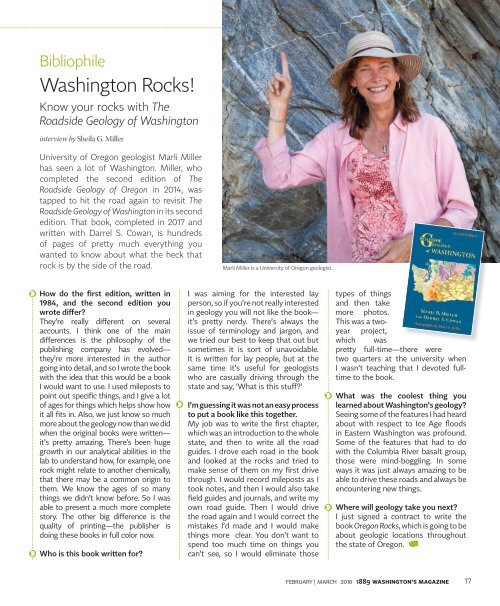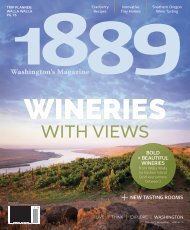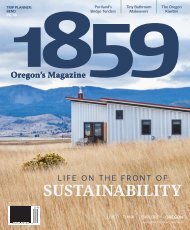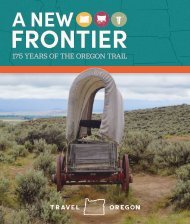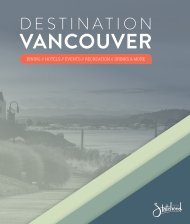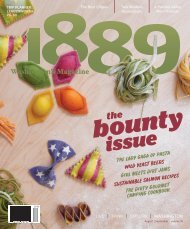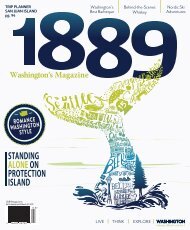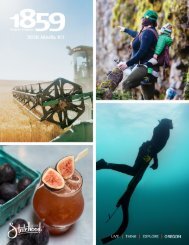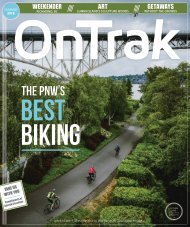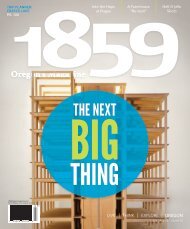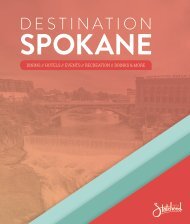You also want an ePaper? Increase the reach of your titles
YUMPU automatically turns print PDFs into web optimized ePapers that Google loves.
say wa?<br />
Bibliophile<br />
Washington Rocks!<br />
Know your rocks with The<br />
Roadside Geology of Washington<br />
interview by Sheila G. Miller<br />
University of Oregon geologist Marli Miller<br />
has seen a lot of Washington. Miller, who<br />
completed the second edition of The<br />
Roadside Geology of Oregon in 2014, was<br />
tapped to hit the road again to revisit The<br />
Roadside Geology of Washington in its second<br />
edition. That book, completed in 2017 and<br />
written with Darrel S. Cowan, is hundreds<br />
of pages of pretty much everything you<br />
wanted to know about what the heck that<br />
rock is by the side of the road.<br />
Marli Miller is a University of Oregon geologist.<br />
How do the first edition, written in<br />
1984, and the second edition you<br />
wrote differ?<br />
They’re really different on several<br />
accounts. I think one of the main<br />
differences is the philosophy of the<br />
publishing company has evolved—<br />
they’re more interested in the author<br />
going into detail, and so I wrote the book<br />
with the idea that this would be a book<br />
I would want to use. I used mileposts to<br />
point out specific things, and I give a lot<br />
of ages for things which helps show how<br />
it all fits in. Also, we just know so much<br />
more about the geology now than we did<br />
when the original books were written—<br />
it’s pretty amazing. There’s been huge<br />
growth in our analytical abilities in the<br />
lab to understand how, for example, one<br />
rock might relate to another chemically,<br />
that there may be a common origin to<br />
them. We know the ages of so many<br />
things we didn’t know before. So I was<br />
able to present a much more complete<br />
story. The other big difference is the<br />
quality of printing—the publisher is<br />
doing these books in full color now.<br />
Who is this book written for?<br />
I was aiming for the interested lay<br />
person, so if you’re not really interested<br />
in geology you will not like the book—<br />
it’s pretty nerdy. There’s always the<br />
issue of terminology and jargon, and<br />
we tried our best to keep that out but<br />
sometimes it is sort of unavoidable.<br />
It is written for lay people, but at the<br />
same time it’s useful for geologists<br />
who are casually driving through the<br />
state and say, ‘What is this stuff?’<br />
I’m guessing it was not an easy process<br />
to put a book like this together.<br />
My job was to write the first chapter,<br />
which was an introduction to the whole<br />
state, and then to write all the road<br />
guides. I drove each road in the book<br />
and looked at the rocks and tried to<br />
make sense of them on my first drive<br />
through. I would record mileposts as I<br />
took notes, and then I would also take<br />
field guides and journals, and write my<br />
own road guide. Then I would drive<br />
the road again and I would correct the<br />
mistakes I’d made and I would make<br />
things more clear. You don’t want to<br />
spend too much time on things you<br />
can’t see, so I would eliminate those<br />
types of things<br />
and then take<br />
more photos.<br />
This was a twoyear<br />
project,<br />
which was<br />
pretty full-time—there were<br />
two quarters at the university when<br />
I wasn’t teaching that I devoted fulltime<br />
to the book.<br />
What was the coolest thing you<br />
learned about Washington’s geology?<br />
Seeing some of the features I had heard<br />
about with respect to Ice Age floods<br />
in Eastern Washington was profound.<br />
Some of the features that had to do<br />
with the Columbia River basalt group,<br />
those were mind-boggling. In some<br />
ways it was just always amazing to be<br />
able to drive these roads and always be<br />
encountering new things.<br />
Where will geology take you next?<br />
I just signed a contract to write the<br />
book Oregon Rocks, which is going to be<br />
about geologic locations throughout<br />
the state of Oregon.<br />
FEBRUARY | MARCH <strong>2018</strong> <strong>1889</strong> WASHINGTON’S MAGAZINE 17


